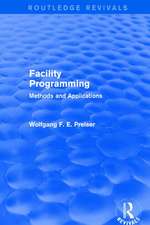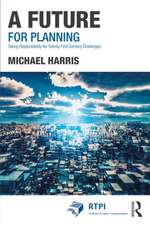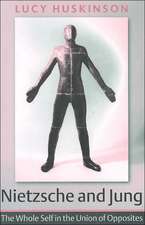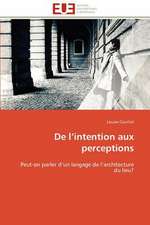Architecture and the Mimetic Self: A Psychoanalytic Study of How Buildings Make and Break Our Lives
Autor Lucy Huskinsonen Limba Engleză Hardback – 14 feb 2018
Criteria for effective architectural design have for a long time been grounded in utilitarian and aesthetic principles of function, efficiency, cost, and visual impact. Although these are important considerations, they often fail to meet the fundamental needs of those who inhabit and use buildings. Misconceptions are rife, not least because our responses to architecture are often difficult to measure, and are in large part unconscious. By bridging psychoanalytic thought and architectural theory, Architecture and the Mimetic Self frees the former from its preoccupations with interpersonal human relations to address the vital relationships that we establish with our nonhuman environments.
In addition to providing a guide to the unconscious behaviours that are most relevant for evaluating architectural design, this book explains how our relationships with the built environment inform a more expansive and useful psychoanalytic theory of human relationship and identity. It will appeal to psychoanalysts and analytical psychologists, architects, and all who are interested in the overlaps of psychology, architecture, and the built environment.
| Toate formatele și edițiile | Preț | Express |
|---|---|---|
| Paperback (1) | 320.93 lei 6-8 săpt. | |
| Taylor & Francis – 7 feb 2018 | 320.93 lei 6-8 săpt. | |
| Hardback (1) | 785.40 lei 6-8 săpt. | |
| Taylor & Francis – 14 feb 2018 | 785.40 lei 6-8 săpt. |
Preț: 785.40 lei
Preț vechi: 878.15 lei
-11% Nou
Puncte Express: 1178
Preț estimativ în valută:
150.29€ • 160.71$ • 125.31£
150.29€ • 160.71$ • 125.31£
Carte tipărită la comandă
Livrare economică 17 aprilie-01 mai
Preluare comenzi: 021 569.72.76
Specificații
ISBN-13: 9780415693035
ISBN-10: 0415693039
Pagini: 266
Ilustrații: 41
Dimensiuni: 156 x 234 mm
Greutate: 0.59 kg
Ediția:1
Editura: Taylor & Francis
Colecția Routledge
Locul publicării:Oxford, United Kingdom
ISBN-10: 0415693039
Pagini: 266
Ilustrații: 41
Dimensiuni: 156 x 234 mm
Greutate: 0.59 kg
Ediția:1
Editura: Taylor & Francis
Colecția Routledge
Locul publicării:Oxford, United Kingdom
Public țintă
Postgraduate, Professional, and Professional Practice & DevelopmentCuprins
Acknowledgements
List of figures
CHAPTER ONE INTRODUCTION: BUILDINGS DESIGN US AS MUCH AS WE THEM
CHAPTER TWO ARCHITECTURAL BLUEPRINTS OF PSYCHE
CHAPTER THREE THE ARCHITECTURAL EVENT: BUILDINGS AS EVENTS THAT DISCLOSE OUR BEING
CHAPTER FOUR THE BODY’S ROLE IN THE ARCHITECTURAL EVENT: FORTIFICATION AND CONTAINMENT
CHAPTER FIVE USING ARCHITECTURE TO THINK OURSELVES INTO BEING:
BUILDINGS AS STOREHOUSES OF UNCONSCIOUS THOUGHT
CHAPTER SIX THE SELF THAT IS DISCLOSED THROUGH ARCHITECTURE
CHAPTER SEVEN CONCLUSION: ARCHITECTURE THAT CAPTURES THE IMAGINATION: DESIGNING AND RESPONDING TO EVOCATIVE ARCHITECTURE
List of figures
CHAPTER ONE INTRODUCTION: BUILDINGS DESIGN US AS MUCH AS WE THEM
CHAPTER TWO ARCHITECTURAL BLUEPRINTS OF PSYCHE
CHAPTER THREE THE ARCHITECTURAL EVENT: BUILDINGS AS EVENTS THAT DISCLOSE OUR BEING
CHAPTER FOUR THE BODY’S ROLE IN THE ARCHITECTURAL EVENT: FORTIFICATION AND CONTAINMENT
CHAPTER FIVE USING ARCHITECTURE TO THINK OURSELVES INTO BEING:
BUILDINGS AS STOREHOUSES OF UNCONSCIOUS THOUGHT
CHAPTER SIX THE SELF THAT IS DISCLOSED THROUGH ARCHITECTURE
CHAPTER SEVEN CONCLUSION: ARCHITECTURE THAT CAPTURES THE IMAGINATION: DESIGNING AND RESPONDING TO EVOCATIVE ARCHITECTURE
Notă biografică
Lucy Huskinson, Ph.D, is Senior Lecturer in the School of History, Philosophy, and Social Sciences at Bangor University, UK. She is author and editor of various books and articles on philosophy, psychoanalysis, and the built environment, and co Editor-in-Chief of the International Journal of Jungian Studies.
Recenzii
"In the architectural theorizing of the past decades the psychoanalytic approach has not been very popular. Architectural writings have predominantly dealt with physical forms, focused vision and conscious perceptions and intentionality, instead of the pre-reflective ground of experience and consciousness. Now that the understanding of architecture as a mental and experiential reality rather than aestheticized objects is gaining strength, Lucy Huskinson’s book brings the essential interactions of the self and the setting into the discussion. We are simply not mere observers of architecture, as our very sense of self is molded by our own constructions. Architecture creates the pre-reflective horizons for the experience and understanding of our being in the flesh of the world, to use the beautiful notion of Maurice Merleau-Ponty. This book is a thorough and perceptive survey of the role of the unconsciousness in our interactions with space, place and domicile." --Juhani Pallasmaa, Architect SAFA, HonFAIA, IntFRIBA, Professor Emeritus, Aalto University, International Academy of Architecture, and author of several works on architectural theory, including The Eyes of the Skin: Architecture and the Senses (John Wiley & Sons, 1996)
"The intimate relationship between building and self is captured by the single word "world" (old German "wer") which means "man." Etymology can provide, however, only an insight. Its detailed unfolding calls for a scholar of philosophical perspicacity and psychoanalytic skill, a rare combination of virtues that very few have. Dr. Lucy Huskinson is one of the very few. For evidence, read Architecture and the Mimetic Self". --Yi-Fu Tuan, J. K. Wright Emeritus Professor of Geography and the Vilas Professor Emeritus of Geography at the University of Wisconsin-Madison, USA; acclaimed author, and winner of the Vautrin-Lud International Geography Prize.
"Much contemporary architecture is efficient, clean cut and clever but lacks responsiveness to real human needs, with consequences for our wellbeing. Lucy Huskinson in Architecture and the Mimetic Self encourages us to look at these needs, further for authentic sources of enrichment, renewal and integration.
In what she calls an Architectural blueprint of being, we become our buildings and they become us in a creative reciprocity balancing surety of containment with freedom to explore the uncertainties of ourselves and our environment. She suggests a place in this Architectural event for a loosening: a playfulness, ambiguity and surprise that can engage support and revivify us, setting in motion a new self-awareness to find the means to keep on recreating ourselves.
This is a scholarly and timely contribution to the understanding and possibilities of a more fully human architecture." --Gregory Burgess (AM), award winning architect; recipient of the Sir Zelman Cowen Award for Public Buildings, the Victorian Architecture Medal for the best building of the year, the Australian Institute of Architects Gold Medal, the Robert Mathew Award for the development of architecture in the Commonwealth, and twice awarded the Kenneth F Brown Asia Pacific Culture and Architectural Design Award. He was appointed a Member of the Order of Australia (AM) in the Queen’s Birthday 2011 Honours List, for service to architecture in the area of environmentally sensitive building design and community.
"Arguably architecture has become increasingly commodified, drained as it is of any psychological intent and associated meaning. In Architecture and the Mimetic Self Lucy Huskinson addresses this issue comprehensively, by drawing on an extensive command of psychoanalytical theory, and applying it to our innate and personal experiences of the ways in which buildings affect us" --Flora Samuel, Professor of Architecture in the Built Environment, University of Reading, UK.
"The intimate relationship between building and self is captured by the single word "world" (old German "wer") which means "man." Etymology can provide, however, only an insight. Its detailed unfolding calls for a scholar of philosophical perspicacity and psychoanalytic skill, a rare combination of virtues that very few have. Dr. Lucy Huskinson is one of the very few. For evidence, read Architecture and the Mimetic Self". --Yi-Fu Tuan, J. K. Wright Emeritus Professor of Geography and the Vilas Professor Emeritus of Geography at the University of Wisconsin-Madison, USA; acclaimed author, and winner of the Vautrin-Lud International Geography Prize.
"Much contemporary architecture is efficient, clean cut and clever but lacks responsiveness to real human needs, with consequences for our wellbeing. Lucy Huskinson in Architecture and the Mimetic Self encourages us to look at these needs, further for authentic sources of enrichment, renewal and integration.
In what she calls an Architectural blueprint of being, we become our buildings and they become us in a creative reciprocity balancing surety of containment with freedom to explore the uncertainties of ourselves and our environment. She suggests a place in this Architectural event for a loosening: a playfulness, ambiguity and surprise that can engage support and revivify us, setting in motion a new self-awareness to find the means to keep on recreating ourselves.
This is a scholarly and timely contribution to the understanding and possibilities of a more fully human architecture." --Gregory Burgess (AM), award winning architect; recipient of the Sir Zelman Cowen Award for Public Buildings, the Victorian Architecture Medal for the best building of the year, the Australian Institute of Architects Gold Medal, the Robert Mathew Award for the development of architecture in the Commonwealth, and twice awarded the Kenneth F Brown Asia Pacific Culture and Architectural Design Award. He was appointed a Member of the Order of Australia (AM) in the Queen’s Birthday 2011 Honours List, for service to architecture in the area of environmentally sensitive building design and community.
"Arguably architecture has become increasingly commodified, drained as it is of any psychological intent and associated meaning. In Architecture and the Mimetic Self Lucy Huskinson addresses this issue comprehensively, by drawing on an extensive command of psychoanalytical theory, and applying it to our innate and personal experiences of the ways in which buildings affect us" --Flora Samuel, Professor of Architecture in the Built Environment, University of Reading, UK.
Descriere
Buildings shape our identity and sense of self in profound ways that are not always evident to architects and town planners, or even to those who think they are intimately familiar with the buildings they inhabit. Architecture and the Mimetic Self provides a useful theoretical guide to our unconscious behaviour in relation to buildings, and explains both how and why we are drawn to specific elements and features of architectural design. It reveals how even the most uninspiring of buildings can be modified to meet our unconscious expectations and requirements of them—and, by the same token, it explores the repercussions for our wellbeing when buildings fail to do so.














